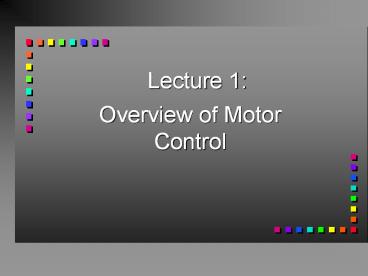Overview of Motor Control - PowerPoint PPT Presentation
Title:
Overview of Motor Control
Description:
Lecture 1: Overview of Motor Control What is Motor Control? The big picture... Motor Behavior An area of study stressing primarily the principles of human skilled ... – PowerPoint PPT presentation
Number of Views:277
Avg rating:3.0/5.0
Title: Overview of Motor Control
1
Lecture 1
- Overview of Motor Control
2
What is Motor Control?
3
The big picture...
4
Motor Behavior
- An area of study stressing primarily the
principles of human skilled movement generated at
a behavioral level of analysis.
5
Motor Behavior
- Action
- Perception
- Cognition
- Interaction of individual, task and environment.
6
Motor Control
- An area of study dealing with the understanding
of the neural, physiological and behavioral
aspects of movements.
7
Two main aspects of motor control
- Stabilizing the body in space, postural and
balance control. - Moving the body in space, movement.
8
Motor Learning
- A set of internal processes associated with
practice or experience leading to relatively
permanent changes in the capability of motor
skill.
9
Motor Development
- A field of study concerning the changes in motor
bahavior occuring as a result of growth,
maturation and experience.
10
Task
Individual
Motor control
Environment
11
Why should we study motor control?
- Improving movement capability following injury to
guide clinical intervention. - Improving motor performance.
- Generating and building theory.
12
Theory vs. Model in Motor Control
- A theory of motor control is a group of abstract
ideas about the nature and cause of movement.
- A model is a represetation of something, usually
a simplified version of the real thing.
13
Theories of Motor Control
14
Reflex theory
- The building blocks of complex behavior.
- Sir Charles Sherrington, neurophisiologist (The
Integrative Action of the Nervous System), 1906. - Classified the major responses to stimuli, and
believed that most of the voluntary movements
resulted from these fundamental reflexes.
15
- Stimulus Response Response
- Sensory receptor Effector(muscle)
16
Information processing model
- Input
- (Signals)
- Processing
- (The human)
- Output
- (Motor response)
17
Information processing model
- Stimulus Stimulus Response Response
Movement - (Input) iden. selection progra.
output - REACTION TIME
- THE HUMAN
18
Hierarchical Theory
- Top - down structure
- Reflexes are part of this hierarchy, normally
higher centers inhibit them - (Chart to be scanned)
- Motor control emerges from reflexes, later on
integrated with higher control levels. - Limitations
19
Motor programming theories
- Sensory input not essential to drive movement but
important function in modulating it. - Try for yourself (signature) demo.
- Limitations
20
Dynamical Systems theory
- Bernstein-characteristics of acting systems,
external and internal forces. - Distributed model of motor control-no need for
higher center of control. - Interaction of elements, physical and neural
components. - Limitations
21
(No Transcript)
22
- Parallel distributed processing theory.
- NS processes information in serial and parallel.
- Limitations
23
Task oriented theories
- Control of movement is organized around
goal-directed functional behaviors such as
walking or talking. - Limitations
24
Ecological theory.
- How do we detect information in our environment
that is important to our actions? - Limitations































